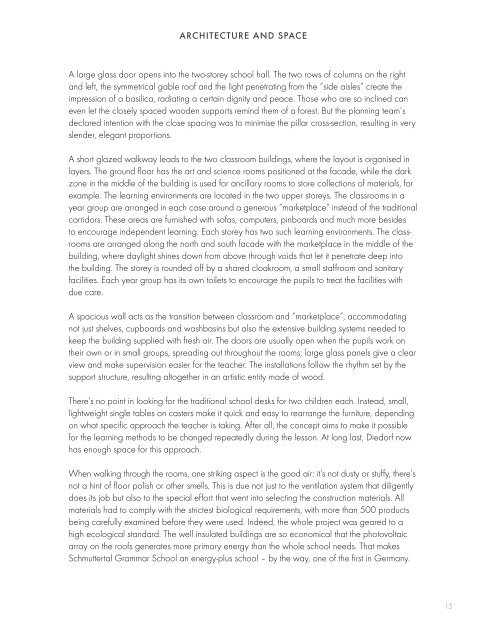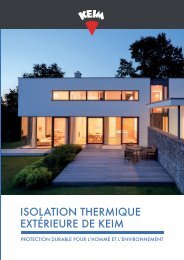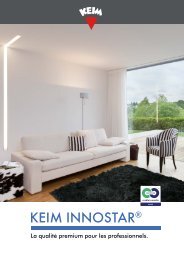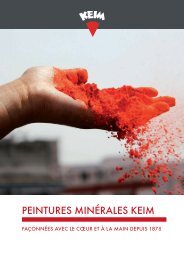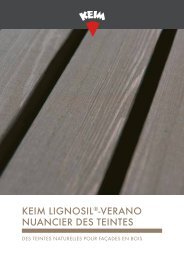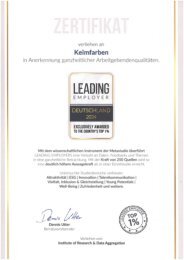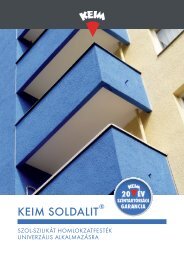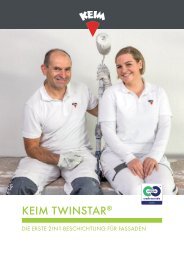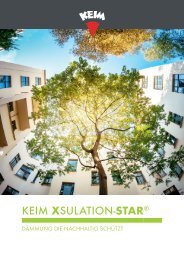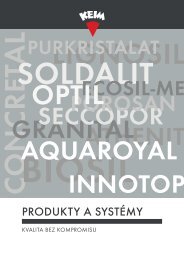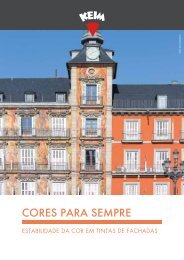KEIM Edition No. 2: Schmuttertal Grammar School
You also want an ePaper? Increase the reach of your titles
YUMPU automatically turns print PDFs into web optimized ePapers that Google loves.
ARCHITECTURE AND SPACE<br />
A large glass door opens into the two-storey school hall. The two rows of columns on the right<br />
and left, the symmetrical gable roof and the light penetrating from the “side aisles” create the<br />
impression of a basilica, radiating a certain dignity and peace. Those who are so inclined can<br />
even let the closely spaced wooden supports remind them of a forest. But the planning team‘s<br />
declared intention with the close spacing was to minimise the pillar cross-section, resulting in very<br />
slender, elegant proportions.<br />
A short glazed walkway leads to the two classroom buildings, where the layout is organised in<br />
layers. The ground floor has the art and science rooms positioned at the facade, while the dark<br />
zone in the middle of the building is used for ancillary rooms to store collections of materials, for<br />
example. The learning environments are located in the two upper storeys. The classrooms in a<br />
year group are arranged in each case around a generous “marketplace” instead of the traditional<br />
corridors. These areas are furnished with sofas, computers, pinboards and much more besides<br />
to encourage independent learning. Each storey has two such learning environments. The classrooms<br />
are arranged along the north and south facade with the marketplace in the middle of the<br />
building, where daylight shines down from above through voids that let it penetrate deep into<br />
the building. The storey is rounded off by a shared cloakroom, a small staffroom and sanitary<br />
facilities. Each year group has its own toilets to encourage the pupils to treat the facilities with<br />
due care.<br />
A spacious wall acts as the transition between classroom and “marketplace”, accommodating<br />
not just shelves, cupboards and washbasins but also the extensive building systems needed to<br />
keep the building supplied with fresh air. The doors are usually open when the pupils work on<br />
their own or in small groups, spreading out throughout the rooms; large glass panels give a clear<br />
view and make supervision easier for the teacher. The installations follow the rhythm set by the<br />
support structure, resulting altogether in an artistic entity made of wood.<br />
There’s no point in looking for the traditional school desks for two children each. Instead, small,<br />
lightweight single tables on casters make it quick and easy to rearrange the furniture, depending<br />
on what specific approach the teacher is taking. After all, the concept aims to make it possible<br />
for the learning methods to be changed repeatedly during the lesson. At long last, Diedorf now<br />
has enough space for this approach.<br />
When walking through the rooms, one striking aspect is the good air: it’s not dusty or stuffy, there’s<br />
not a hint of floor polish or other smells. This is due not just to the ventilation system that diligently<br />
does its job but also to the special effort that went into selecting the construction materials. All<br />
materials had to comply with the strictest biological requirements, with more than 500 products<br />
being carefully examined before they were used. Indeed, the whole project was geared to a<br />
high ecological standard. The well insulated buildings are so economical that the photovoltaic<br />
array on the roofs generates more primary energy than the whole school needs. That makes<br />
<strong>Schmuttertal</strong> <strong>Grammar</strong> <strong>School</strong> an energy-plus school – by the way, one of the first in Germany.<br />
15


